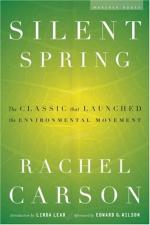|
This section contains 514 words (approx. 2 pages at 400 words per page) |

|
The Rise of Synthetic Pesticides
So influential a role did Carson's Silent Spring play in the quickening of concern about pesticides that it is often assumed that she was the first to call attention to the problem. But pesticides had been in wide use since the nineteenth century, and debates about their effects on health had been going on for decades. But the nature of the chemical threat changed dramatically after World War II, and Carson was the first popular writer to explain this development to Americans.
During the early twentieth century, the most commonly used chemical pesticides were arsenic compounds. They were deadly enough to cause a few health scares, but a far cry from the poisons that wartime chemical weapons research bequeathed to the worldan entirely new and ever expanding family of man-made toxins called organochlorines, the most notorious of which was DDT. The new...
|
This section contains 514 words (approx. 2 pages at 400 words per page) |

|




